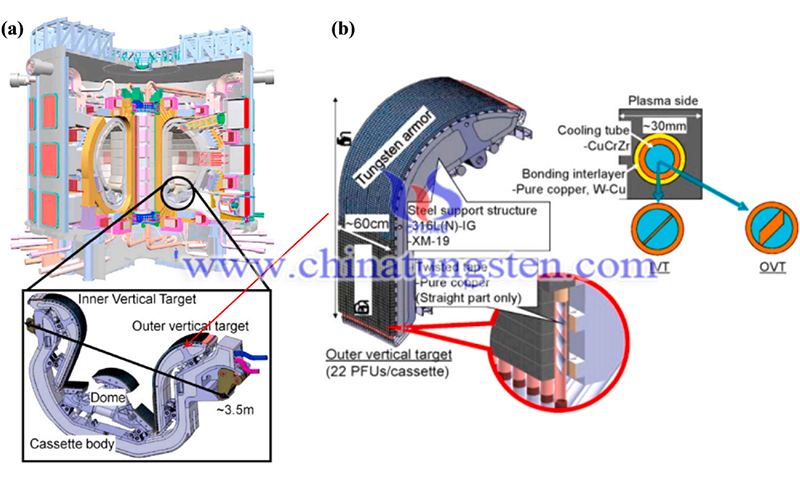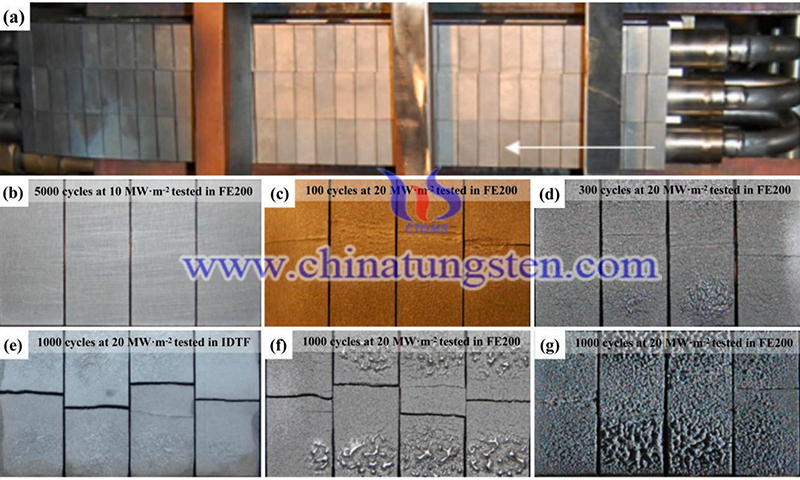Tungsten Alloys, Ideal Candidate for Nuclear Fusion Applications
- Details
- Category: Tungsten's News
- Published on Wednesday, 19 April 2023 17:57
Tungsten is widely used in nuclear fusion reactors as a highly regarded plasma-oriented material (PFM). However, it has poor oxidation resistance at high temperatures. In the event of a reactor de-cooling accident, the tungsten alloy is rapidly oxidized and volatilized as air enters the vacuum chamber, which will cause a catastrophic nuclear leakage accident. Scholars have conducted a lot of research and pointed out that the development of self-passivating tungsten alloys and surface protection technology is an effective way to solve this problem.

Nuclear energy is currently considered to be one of the most promising energy sources. According to the principle of nuclear fusion, a controlled hydrogen fusion reaction to produce fusion energy is the ideal way to solve the energy problem in the future. As an important component of the International Thermal Fusion Experimental Reactor (ITER), the reliability and stability of the shunt will remain a key factor in the stable output of nuclear energy. The shunt and the outer plasma surface material (PFM) are exposed to high beam low energy plasma (H and He particles) for a long time and need to withstand damage caused by high heat flow (HHF), high energy particles, electromagnetic radiation, and neutron irradiation (14 MeV) from high energy fusion reactions.
Therefore, there are strict requirements for the performance of PFM. Tungsten is considered to be the ideal PFM because of its excellent properties such as high melting point, high thermal conductivity, low physical sputtering rate, low fuel retention, and low neutron activation. However, surface melting, cracking, recrystallization embrittlement, and irradiation hardening (embrittlement) of tungsten and its alloys can easily occur in nuclear reactors, leading to severe surface bulging and fracture. Especially when a loss of coolant accident (LOCA) occurs, the surface temperature of the first wall will reach more than 1000°C within a few days due to decay and heat release of the elements after neutron irradiation in the absence of coolant.
After air and steam enter the vacuum chamber through the fissure, the tungsten armor will undergo catastrophic oxidation. The tungsten armor is oxidized to volatile and highly radioactive WO3 in a short time. finally, it will disappear completely within 1-2 months, which will cause incalculable catastrophic effects. Tungsten is widely used in the first wall of the shunt and cladding because of its excellent properties. surface assemblies (PFCs). Among them, the most representative outer vertical target (OVT) element and the CB are connected via nickel-aluminum-copper pins.
The upper bend of the OVT is covered by a W-based armor to avoid the highest heat flow in the PFC during steady state, thermal transient periods, and ITER interruptions. Therefore, the component material must be highly refractory and reliable. w-based alloy bricks are strung together by cooling tubes and fixed to the cross-section of the OVT. This design not only improves the heat dissipation capability of the system but also avoids the dropping of the armor bricks. In addition, the heat dissipation capability and critical heat flux performance of the OVT can be further improved by inserting a pure copper tap into the cooling tube.

Reference: Fu T, Cui K, Zhang Y, et al. Oxidation protection of tungsten alloys for nuclear fusion applications: A comprehensive review[J]. Journal of Alloys and Compounds, 2021, 884: 161057.
- Tungsten Manufacturer & Supplier, Chinatungsten Online: www.chinatungsten.com
- Tungsten News & Prices of China Tungsten Industry Association: www.ctia.com.cn
- Molybdenum News & Price: news.molybdenum.com.cn
- Tel.: 86 592 5129696; Fax: 86 592 5129797; Email: sales@chinatungsten.com



 sales@chinatungsten.com
sales@chinatungsten.com